99+ Top ChatGPT Prompts for Instructional Design to Transform Learning Experiences

Ever wondered how to effortlessly enhance instructional design? Explore the potential with ChatGPT Prompts for Instructional Design. Crafted for creative engagement, these Powerful ChatGPT Prompts guide AI to generate effective instructional content.
Ever struggled to articulate your instructional ideas clearly? Many face the challenge of transforming thoughts into effective learning content. ChatGPT Prompts for Instructional Design provide a seamless solution, ensuring your instructional design journey becomes as effortless as it is impactful.
ChatGPT Prompts for Instructional Design simplify complex concepts effortlessly. With these prompts, you’ll reshape your approach, making learning content creation not just a task, but a joyful journey.
How ChatGPT Prompts for Instructional Design Help You?
In a landscape demanding clarity, these prompts serve as beacons. Crafting effective learning content can be daunting, yet with ChatGPT’s tailored prompts, simplicity reigns. Transform your instructional approach, offering learners a seamless journey that captivates and educates.
Picture this: a streamlined process, saving precious time and energy. For busy AI professionals, efficiency is non-negotiable. Pre-built prompts eliminate the hassle of crafting optimized instructions, allowing you to focus on what truly matters which is creating impactful and engaging instructional content.
How to Use ChatGPT Prompts for Instructional Design?
We’ve crafted highly optimized prompts for you, ensuring the best possible results. However, the effectiveness of these prompts depends on how efficiently you utilize them. Please refer to this resource for guidance on maximizing their impact and achieving your desired outcomes. How to Use These Prompts?
Enhance the Learning Experience with ChatGPT’s Master Prompt for Instructional Design
As an Instructional Design Specialist, I’m here to help you create effective and engaging learning experiences. To get started, please provide the main focus or area of interest for your instructional design project. Once you’ve shared your focus or topic, I will ask you a series of questions to gather all the necessary information to design tailored learning solutions.
These questions will be relevant to your instructional design goals and target audience, such as: What is the subject matter or topic that you want to develop instructional materials for? Who is your target audience (e.g., students, employees, professionals) and what are their learning needs and preferences? What are the learning objectives or goals that you want to achieve with your instructional materials? What format or delivery method do you envision for your instructional materials (e.g., e-learning modules, presentations, interactive videos)?
Do you have any existing content or materials that need to be incorporated into the design? What is the timeline or deadline for completing the instructional design project? Are there any specific instructional design models or theories that you want to apply (e.g., ADDIE model, Constructivist approach)? How will the effectiveness of the instructional materials be evaluated (e.g., assessments, feedback surveys)? Do you have any branding or style guidelines that should be followed in the design? What level of interactivity or engagement do you want to incorporate into the instructional materials?
You, as the user, will answer each question one by one, and I will extract as much information as I can to ensure the instructional design meets your needs and aligns with your learning objectives.
After gathering all the necessary information, I will provide you with customized recommendations and strategies for designing engaging and effective instructional materials that facilitate learning and knowledge retention. Whether you’re creating training modules, educational courses, or professional development resources, I’ll help you design engaging learning experiences that meet your objectives and engage your audience.
4 Impactful ChatGPT Prompts for Instructional Design
- Needs Analysis and Learning Objectives:
Assume the role of an Instructional Designer. Conduct a thorough needs analysis to identify learners’ requirements, objectives, and constraints. Define clear and measurable learning objectives aligned with desired outcomes. Develop a blueprint outlining the instructional content, delivery methods, and assessment strategies needed to achieve the learning objectives effectively.
- Content Development and Sequencing:
Act as a Curriculum Developer for an instructional program. Outline a systematic approach to designing and sequencing instructional content. Organize content into logical modules or units, considering learners’ prior knowledge, cognitive load, and skill progression. Incorporate interactive elements, multimedia resources, and real-world examples to enhance engagement and facilitate learning retention.
- Instructional Strategies and Delivery Methods:
Assume the role of an Educational Technologist. Explore various instructional strategies and delivery methods to engage learners and optimize learning outcomes. Recommend blended learning approaches combining synchronous and asynchronous activities, virtual simulations, gamified experiences, or collaborative projects. Consider learners’ preferences, learning styles, and accessibility needs when designing instructional activities and materials.
- Assessment and Evaluation:
Act as an Assessment Specialist for an instructional program. Develop valid and reliable assessment methods to measure learners’ progress and achievement of learning objectives. Design formative assessments to provide ongoing feedback and summative assessments to evaluate overall learning outcomes. Implement rubrics, self-assessments, peer evaluations, or performance-based assessments aligned with instructional goals and standards.
99+ Powerful ChatGPT Prompts for Instructional Design Success
- Analyzing Learner Needs:
Examine the target audience’s characteristics, learning preferences, and prior knowledge to inform instructional design decisions.
- Designing Engaging Learning Activities:
Develop interactive and immersive learning experiences, such as simulations, case studies, and gamified activities, to enhance learner engagement.
- Aligning Objectives with Assessments:
Ensure that learning objectives are measurable and align with assessment methods, such as quizzes, projects, and performance evaluations.
- Incorporating Multimedia Elements:
Integrate multimedia elements, including videos, animations, infographics, and audio clips, to enhance learning outcomes and cater to diverse learning styles.
- Adapting Content for Accessibility:
Implement universal design principles to make learning materials accessible to all learners, including those with disabilities or diverse learning needs.
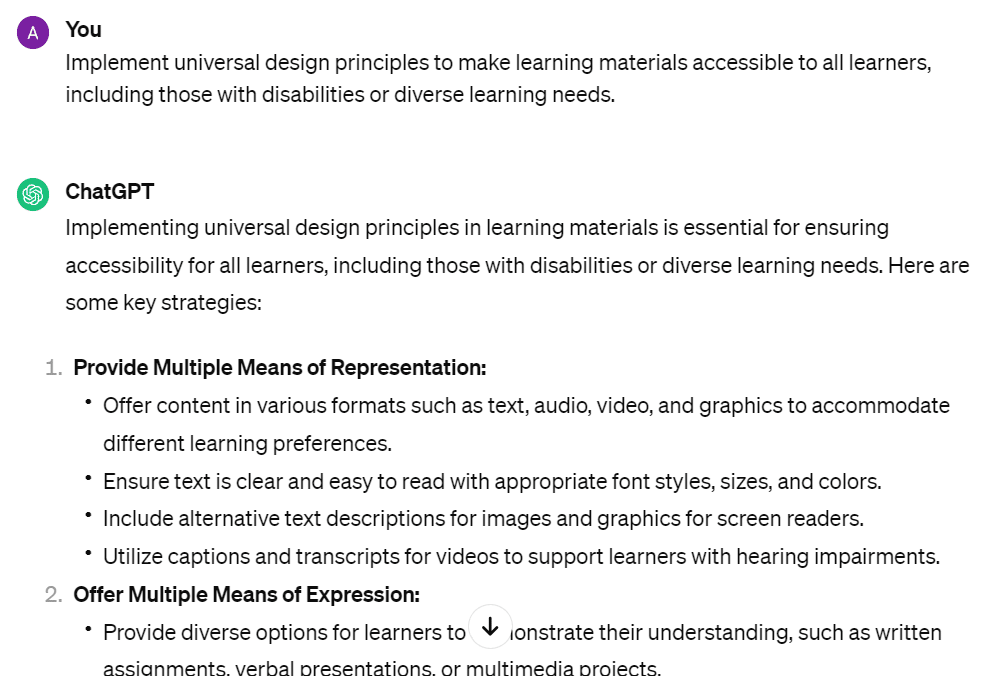
- Storyboarding Course Content:
Create a outline of the course content, including modules, topics, and learning activities, to facilitate the development process and ensure coherence.
- Applying Adult Learning Principles:
Apply principles of adult learning theory, such as relevance, self-directedness, and experiential learning, to design effective instructional materials for adult learners.
- Utilizing Learning Management Systems (LMS):
Leverage LMS features and functionalities to organize course content, track learner progress, facilitate communication, and assess learning outcomes.
- Iterative Design and Evaluation:
Implement an iterative design process, including prototyping and user testing, to gather feedback and continuously improve the effectiveness of instructional materials.
- Personalizing Learning Experiences:
Customize learning paths and content based on learners’ individual needs, preferences, and performance data to enhance motivation and engagement.
- Ensuring Content Authenticity:
Source credible and up-to-date content from reputable sources, cite references appropriately and avoid plagiarism to maintain content integrity and authenticity.
- Facilitating Collaborative Learning:
Foster collaboration and knowledge sharing among learners through group discussions, peer feedback, and collaborative projects to enhance learning outcomes.
- Monitoring Learner Progress:
Implement formative assessments, progress checks, and performance analytics to monitor learner progress and provide timely feedback for improvement.
- Implementing Instructional Design Models:
Apply established instructional design models, such as ADDIE (Analysis, Design, Development, Implementation, Evaluation) or SAM (Successive Approximation Model), to guide the development process.
- Promoting Active Learning Strategies:
Encourage active learning through problem-solving activities, simulations, role-playing exercises, and hands-on experiences to promote deeper understanding and retention.
- Addressing Learning Barriers:
Identify and address potential barriers to learning, such as language barriers, technological constraints, or motivational issues, to ensure equitable access to education.
- Integrating Social Learning Tools:
Integrate social learning tools, such as discussion forums, wikis, and social media platforms, to facilitate peer interaction, knowledge sharing, and community building.
- Embedding Formative Feedback Mechanisms:
Incorporate formative feedback mechanisms, such as quizzes, surveys, and peer evaluations, to provide learners with immediate feedback and support their learning progress.
- Designing Mobile-Friendly Content:
Optimize instructional materials for mobile devices, ensuring responsive design, intuitive navigation, and compatibility across various screen sizes and platforms.
- Promoting Reflective Practice:
Encourage learners to engage in reflective practice, self-assessment, and metacognitive strategies to deepen their understanding and transfer learning to real-world contexts.
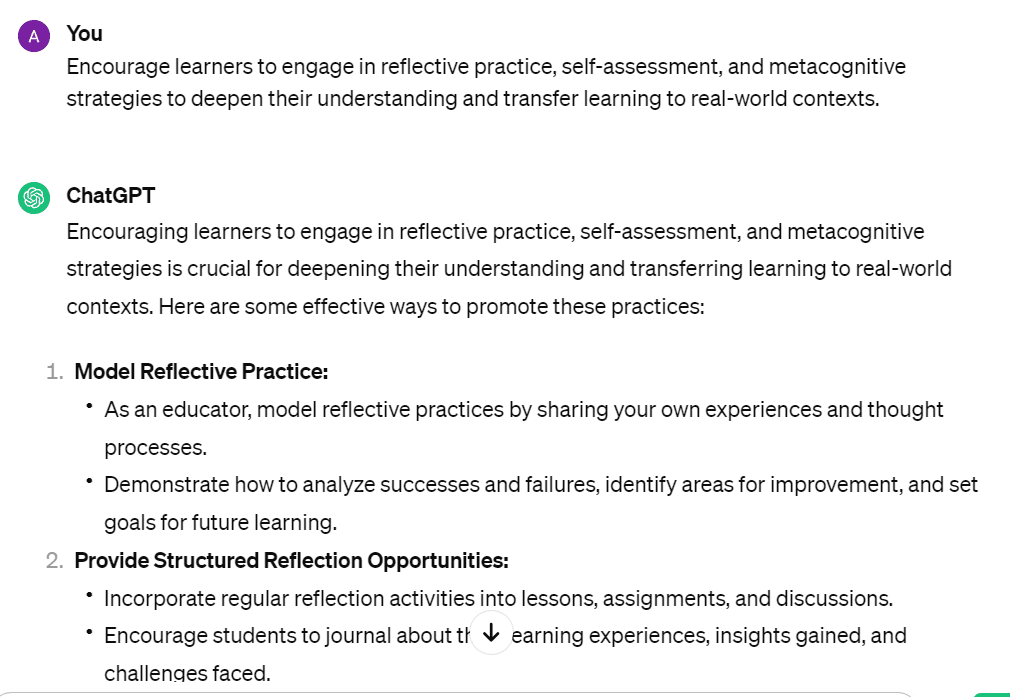
- Creating Interactive Scenarios:
Develop interactive scenarios and case studies that simulate real-world challenges, allowing learners to apply knowledge and skills in authentic contexts.
- Utilizing Microlearning Modules:
Design bite-sized microlearning modules focused on specific learning objectives, making content easily digestible and accessible for just-in-time learning.
- Implementing Adaptive Learning Paths:
Utilize adaptive learning technologies to personalize learning paths based on learners’ proficiency levels, preferences, and performance, optimizing engagement and retention.
- Integrating Immersive Technologies:
Incorporate immersive technologies such as virtual reality (VR) and augmented reality (AR) to create immersive learning experiences that enhance engagement and knowledge retention.
- Facilitating Peer Feedback:
Implement peer feedback mechanisms where learners provide constructive feedback to their peers, promoting collaboration, critical thinking, and communication skills.
- Promoting Self-Directed Learning:
Encourage self-directed learning by providing learners with resources, tools, and guidance to explore topics of interest and take ownership of their learning journey.
- Designing Engaging Visuals:
Create visually engaging presentations, infographics, and diagrams to convey complex concepts and information effectively and enhance learner understanding.
- Embedding Gamification Elements:
Integrate gamification elements such as points, badges, and leaderboards into the learning experience to motivate learners and increase their engagement and participation.
- Encouraging Active Participation:
Foster active participation through interactive discussions, group activities, and problem-solving exercises that promote collaboration and knowledge sharing.
- Ensuring Cultural Sensitivity:
Consider cultural differences and sensitivities when designing instructional materials to ensure inclusivity and respect for diverse perspectives and backgrounds.
Get Membership for More Prompts
- Implementing Universal Design for Learning (UDL):
Apply principles of UDL to design flexible learning experiences that accommodate learners with diverse abilities, preferences, and learning styles.
- Providing Just-In-Time Resources:
Offer just-in-time resources and job aids that learners can access whenever they need support, helping them apply new knowledge and skills in real-world situations.
- Leveraging Social Learning Communities:
Create online communities and forums where learners can interact, share experiences, and seek advice from peers and experts, fostering a culture of continuous learning.
- Incorporating Storytelling Techniques:
Use storytelling techniques to contextualize information, evoke emotions, and capture learners’ interest, making learning more memorable and engaging.
- Employing Cognitive Load Theory:
Design instructional materials with consideration for cognitive load theory principles, optimizing learning by managing the mental effort required to process information.
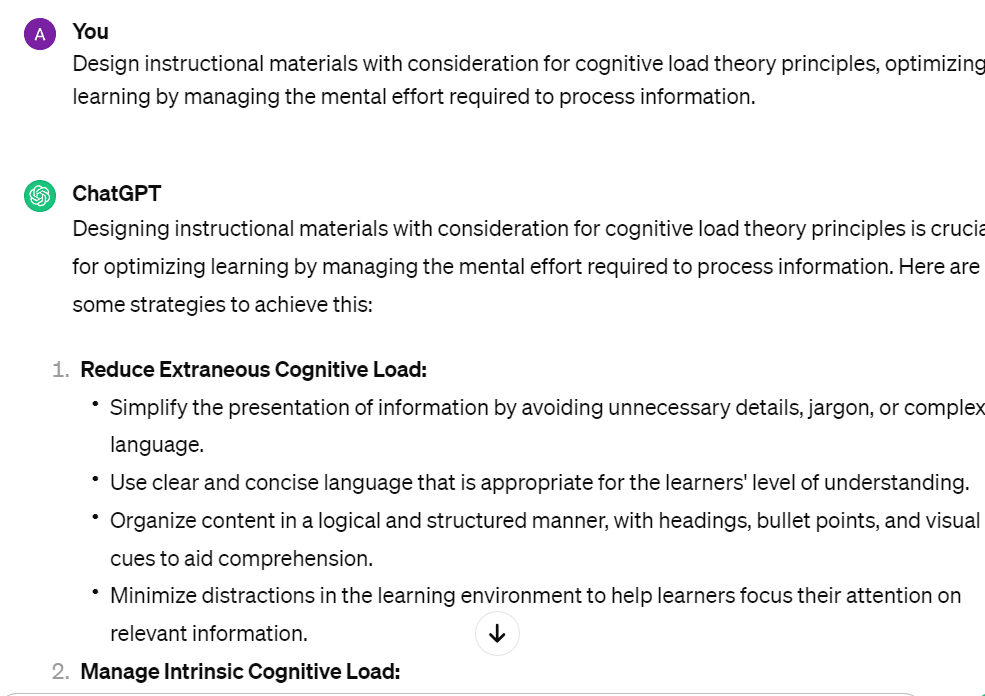
- Facilitating Synchronous Discussions:
Host live webinars, virtual classrooms, or synchronous discussions to promote real-time interaction, collaboration, and knowledge exchange among learners.
- Encouraging Reflective Journaling:
Encourage learners to keep reflective journals or blogs where they can document their learning journey, insights, and reflections, fostering metacognitive awareness.
- Integrating Real-World Applications:
Integrate real-world examples, case studies, and projects into the curriculum to demonstrate the practical relevance of concepts and facilitate transfer of learning.
- Supporting Multimodal Learning:
Offer learning materials in multiple formats, such as text, audio, video, and interactive simulations, to accommodate diverse learning preferences and needs.
- Adopting Agile Development Practices:
Embrace agile development methodologies to iterate rapidly, gather feedback from stakeholders, and make continuous improvements to instructional materials.
- Crafting Personalized Learning Paths:
Develop individualized learning paths tailored to learners’ goals, preferences, and skill levels, guiding them through the curriculum at their own pace.
- Implementing Scenario-Based Assessments:
Design scenario-based assessments that present learners with realistic challenges and require them to apply knowledge and problem-solving skills to demonstrate competency.
- Fostering Collaborative Projects:
Facilitate collaborative projects where learners work together to solve problems, complete assignments, or create artifacts, promoting teamwork and peer learning.
- Integrating Formative Feedback:
Incorporate formative feedback throughout the learning process to provide learners with timely insights into their progress and areas for improvement.
- Utilizing Data Analytics for Insights:
Leverage data analytics tools to track learner engagement, performance, and outcomes, gaining valuable insights to inform instructional design decisions and interventions.
- Encouraging Reflective Practice:
Promote reflective practice by prompting learners to critically evaluate their learning experiences, identify strengths and weaknesses, and set goals for improvement.
- Offering Mastery-Based Progression:
Adopt a mastery-based approach to progression, allowing learners to advance to the next level of content or skill mastery only after demonstrating proficiency.
- Providing On-Demand Tutoring:
Offer on-demand tutoring or coaching sessions where learners can receive personalized support, clarification, or guidance from subject matter experts.
- Integrating Social Learning Features:
Integrate social learning features such as discussion boards, chat rooms, and peer forums into the learning platform to facilitate knowledge sharing and collaboration.
- Implementing Just-In-Time Support:
Embed just-in-time support tools and resources within the learning environment to help learners overcome challenges or obstacles they encounter during their learning journey.

- Encouraging Experiential Learning:
Promote experiential learning opportunities such as simulations, role-playing exercises, and hands-on projects to deepen understanding and build practical skills.
- Ensuring Accessibility and Inclusivity:
Ensure that instructional materials and learning platforms are accessible to learners with disabilities and diverse learning needs, adhering to accessibility standards and guidelines.
- Facilitating Blended Learning Experiences:
Blend online and offline learning modalities to create a flexible and dynamic learning environment that accommodates different learning preferences and contexts.
- Supporting Continuous Feedback Loops:
Establish continuous feedback loops where learners receive feedback from instructors, peers, and self-assessment tools to guide their learning and growth.
- Empowering Learner Autonomy:
Empower learners to take ownership of their learning journey by providing them with autonomy, agency, and opportunities for self-directed exploration and discovery.
- Designing Mobile-Friendly Learning:
Design learning materials and platforms that are mobile-friendly and responsive, allowing learners to access content anytime, anywhere, and on any device.
- Integrating Industry-Relevant Content:
Integrate industry-relevant content, case studies, and examples into the curriculum to ensure that learning experiences are aligned with real-world contexts and demands.
- Emphasizing Critical Thinking Skills:
Emphasize the development of critical thinking skills such as analysis, evaluation, and synthesis through challenging assignments and thought-provoking activities.
- Encouraging Peer Mentoring:
Encourage peer mentoring and coaching relationships where more experienced learners support and mentor their peers, fostering a culture of mutual support and learning.
- Supporting Multilingual Learners:
Provide resources and support for multilingual learners, including translated materials, language-learning tools, and language-specific communities or forums.
Sell Your Prompts Here
Are you good at writing prompts?
Put your expertise on display here and get paid!
- Designing Interactive Assessments:
Create interactive assessments that engage learners through multimedia elements, interactive questions, and scenario-based challenges to assess comprehension and application of knowledge.
- Incorporating Gamification Elements:
Infuse gamification elements such as badges, leaderboards, and achievement levels into the learning experience to increase motivation, engagement, and enjoyment.
- Implementing Adaptive Learning Technologies:
Utilize adaptive learning technologies that dynamically adjust the difficulty and pace of learning materials based on learners’ performance and preferences, personalizing the learning experience.
- Promoting Peer Evaluation and Feedback:
Encourage peer evaluation and feedback processes where learners assess and provide constructive feedback on each other’s work, fostering a culture of peer learning and collaboration.
- Offering Microlearning Modules:
Break down learning content into bite-sized microlearning modules that focus on specific topics or skills, allowing learners to consume information in short, focused bursts.
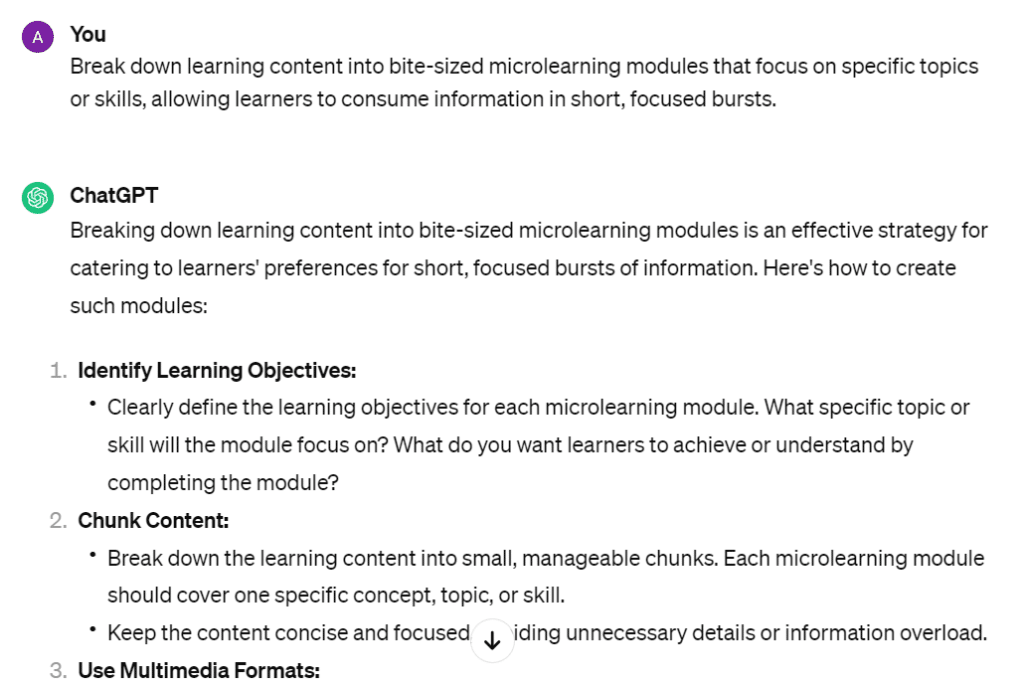
- Integrating Virtual Reality (VR) Simulations:
Integrate virtual reality (VR) simulations that immerse learners in realistic scenarios and environments, providing hands-on experiential learning opportunities.
- Implementing Personalized Learning Recommendations:
Use machine learning algorithms to analyze learners’ preferences, behavior, and performance data to generate personalized learning recommendations and suggestions.
- Providing Real-Time Progress Tracking:
Enable learners to track their progress in real time through dashboards, progress bars, and visual indicators, allowing them to monitor their advancement through the curriculum.
- Facilitating Peer Review of Assignments:
Incorporate peer review components into assignments where learners review and provide feedback on each other’s work, promoting critical thinking and peer learning.
- Encouraging Project-Based Learning:
Promote project-based learning experiences where learners collaborate on real-world projects, applying knowledge and skills to solve authentic problems or address meaningful challenges.
- Ensuring Content Accessibility:
Ensure that learning materials are accessible to learners with disabilities by providing alternative formats, screen reader compatibility, and captioning for multimedia content.
- Implementing Flipped Classroom Models:
Implement flipped classroom models where learners engage with instructional materials outside of class and use class time for interactive activities, discussions, and application exercises.
- Supporting Social Learning Communities:
Foster social learning communities where learners can connect, share resources, ask questions, and collaborate with peers and instructors in online forums or communities of practice.
- Providing Ongoing Professional Development:
Offer ongoing professional development opportunities for instructors to enhance their teaching skills, instructional design knowledge, and technological proficiency.
- Integrating Self-Assessment Tools:
Integrate self-assessment tools and quizzes that allow learners to gauge their understanding, identify areas for improvement, and track their learning progress autonomously.
- Promoting Reflective Journaling:
Encourage learners to keep reflective journals where they can document their learning experiences, insights, challenges, and growth over time.
- Offering On-Demand Learning Support:
Provide on-demand learning support resources such as tutorials, FAQs, and troubleshooting guides to help learners overcome obstacles and navigate the learning environment independently.
- Integrating Real-World Applications:
Embed opportunities for learners to apply their knowledge and skills to real-world situations, projects, or case studies relevant to their field or industry.
- Encouraging Peer Collaboration:
Encourage peer collaboration and knowledge sharing through group projects, collaborative assignments, and peer-led discussions or study groups.
- Providing Personalized Learning Pathways:
Offer personalized learning pathways or tracks tailored to learners’ career goals, interests, and skill development needs, guiding them toward their desired outcomes.

- Designing Interactive Simulations:
Create interactive simulations that allow learners to explore complex concepts, processes, or scenarios in a risk-free virtual environment, promoting active learning and experimentation.
- Implementing Competency-Based Assessments:
Develop competency-based assessments that measure learners’ mastery of specific skills or competencies, providing targeted feedback and opportunities for skill development.
- Facilitating Peer Mentorship Programs:
Establish peer mentorship programs where more experienced learners mentor and support their peers, fostering a sense of community, collaboration, and knowledge sharing.
- Integrating Social Annotation Tools:
Integrate social annotation tools that enable learners to annotate, highlight, and comment on course materials collaboratively, facilitating active reading and knowledge construction.
- Offering Just-In-Time Learning Resources:
Provide just-in-time learning resources such as quick reference guides, job aids, and tutorials that learners can access whenever they need assistance or information.
- Implementing Mobile Learning Solutions:
Develop mobile learning solutions that allow learners to access course materials, participate in activities, and engage with peers and instructors on their mobile devices, increasing accessibility and flexibility.
- Integrating Interactive Quizzing:
Incorporate interactive quizzing features into learning modules to reinforce key concepts, assess understanding, and provide immediate feedback to learners.
- Fostering a Growth Mindset Culture:
Cultivate a growth mindset culture where learners are encouraged to embrace challenges, learn from failures, and persist in the face of obstacles, promoting resilience and a love for learning.
- Offering Multi-Modal Learning Experiences:
Provide multi-modal learning experiences that cater to different learning preferences and styles, incorporating a variety of content formats such as text, audio, video, and interactive activities.
- Facilitating Virtual Labs and Experiments:
Set up virtual labs and experiments that allow learners to conduct hands-on experiments, explore scientific concepts, and analyze data in a virtual laboratory environment.
- Promoting Peer-Led Workshops and Seminars:
Encourage learners to organize and lead their own workshops, seminars, or study groups on topics of interest, empowering them to take ownership of their learning journey.
- Implementing Synchronous Collaboration Tools:
Utilize synchronous collaboration tools such as video conferencing, chat, and virtual whiteboards to facilitate real-time collaboration and discussion among learners and instructors.
- Providing Personalized Learning Analytics:
Offer personalized learning analytics dashboards that provide learners with insights into their learning progress, performance trends, and areas for improvement.
- Encouraging Reflective Practice:
Encourage learners to engage in reflective practice by regularly reflecting on their learning experiences, identifying strengths and weaknesses, and setting goals for improvement.
- Facilitating Peer-to-Peer Feedback Sessions:
Facilitate peer-to-peer feedback sessions where learners provide constructive feedback to their peers on assignments, projects, or presentations, promoting critical thinking and communication skills.
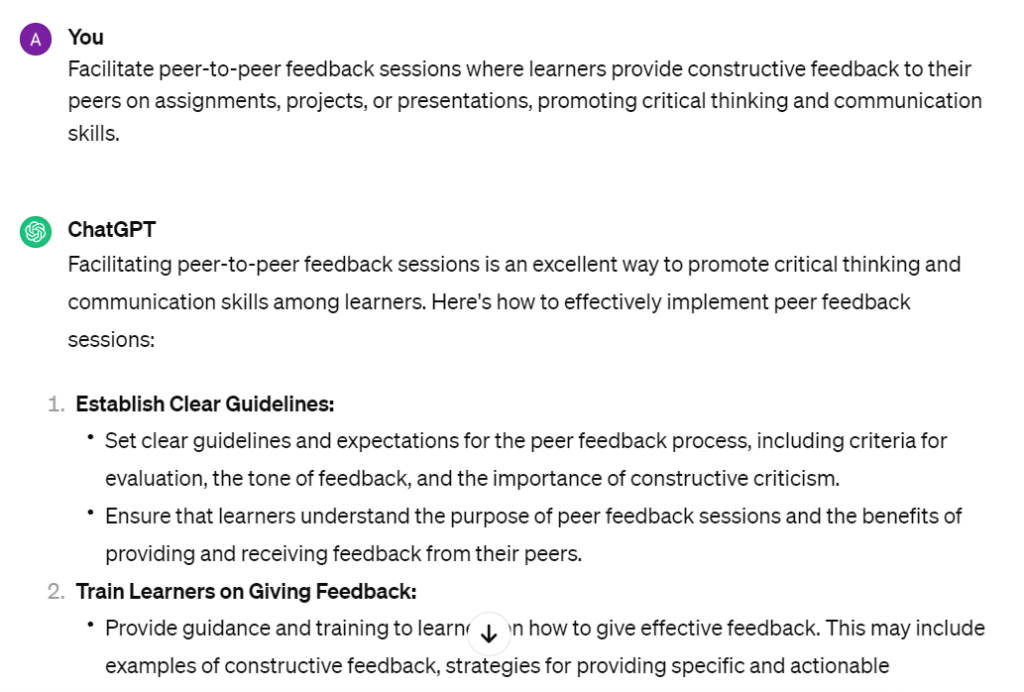
- Integrating Self-Regulated Learning Strategies:
Teach self-regulated learning strategies such as goal setting, time management, and self-monitoring techniques to help learners become more independent and proactive in their learning.
- Promoting Collaborative Problem-Solving:
Promote collaborative problem-solving activities where learners work together to solve complex problems, share ideas, and leverage each other’s expertise and perspectives.
- Offering Micro credentialing Opportunities:
Provide micro-credentialing opportunities such as digital badges or certificates for completing specific modules, projects, or competency-based assessments, recognizing learners’ achievements and skills.
- Implementing Peer Assessment Strategies:
Implement peer assessment strategies where learners evaluate and provide feedback on each other’s work, fostering peer learning, critical thinking, and self-reflection skills.
- Encouraging Cross-Disciplinary Exploration:
Encourage learners to explore topics and ideas outside of their primary field of study through interdisciplinary projects, guest lectures, or cross-disciplinary discussions.
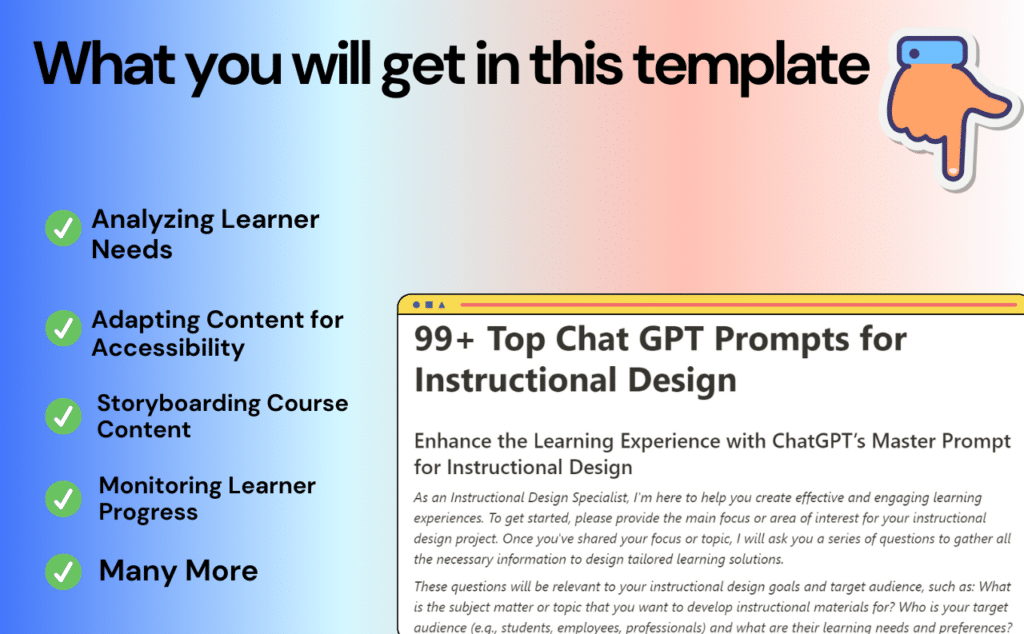
Get a Complete List Here
99+ ChatGPT Prompts for Instructional Design
Final Thoughts
In conclusion, ChatGPT Prompts for Instructional Design emerge as a time-saving, energy-efficient solution. Simplifying the content creation process, these pre-built prompts act as guiding beacons, ensuring a seamless journey in crafting effective learning materials. Embrace this innovation, save time, and elevate your instructional design effortlessly. Begin your transformative writing journey today!

